The roof protects the interior from precipitation, wind and cold. It can be pitched or flat. The second option also has a slope that allows water to drain into organized reception areas. A flat roof is manufactured according to special rules, because it is more influenced by the atmosphere and negative factors than covering with slopes. It is necessary to provide resistance to moisture, water resistance, resistance to air chemistry and sunlight.
The device and structure of a flat roof
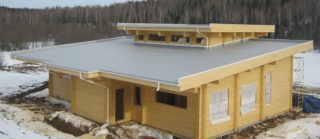
Roofs differ from each other in the composition of materials and the number of layers, but there are layers common to all, which do not change with the development of each individual project.
- As the base of the roof, concrete or reinforced concrete panels are used. This layer contributes to the rigidity of the folding so that the structure can perceive additional forces in the form of the weight of people and auxiliary objects. Flat surfaces are used for entertainment, parking or swimming pools.
- A screed is made along the bearing layer to set the slope of the surface of the desired size. Water enters the drain funnels, due to this uneven layer in height. The screed is made of concrete with a fine filler, usually the slope is 2 - 3 °.
- Protective layers prevent moisture from entering the roof structure. Waterproofing is made from roll or coating materials, bitumen and membranes based on it are used, polymer films and composite compositions are installed.
The composition includes a heat-insulating material, if the purpose of the structure requires it, vapor barrier membranes are added to the coating scheme. The roofing cake contains a lathing or frame base for installing sheet metal roofing, corrugated board, if such a roof is provided.
Advantages and disadvantages
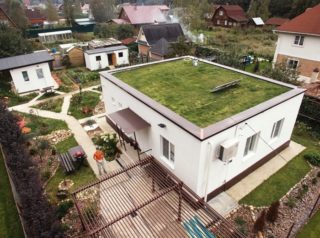
The first advantage of using it is economy. A pitched roof of a simple gable structure requires more construction costs than a flat roof. For a hip or hip design, cheap roll materials are not used, which are used when arranging flat views. Reducing the slope leads to a decrease in the coverage area.
Installation advantage:
- Ease of installation and speed of work. The materials are quickly laid in spite of the large area. The surfacing of rolled building materials can be done by specialists without a high degree of qualification.
- Suitable for high-rise buildings. An increase in the number of storeys leads to an increase in the wind load acting on the upper covering. It is not recommended to make pitched roofs for tall houses, because will have to increase the massiveness of the foundation.
- Rational use of the roof space. The surface is used for arranging recreation areas, a garden, and installing solar panels.
The correct choice of material and adherence to the technology of building a flat roof is required. mistakes lead to premature destruction of the flooring and frequent repairs. During the snowfall period, high sediments are formed, which thaw and threaten additional leaks in weak places.
Varieties of a flat roof
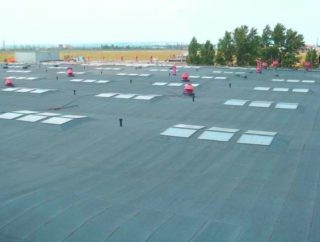
Smooth surfaces on buildings are common in the multi-storey construction sector, in the construction of large workshops, warehouses. A flat roof in a private house is rarely used, only in the case of a terrace, pool or other themed space arrangement. Smooth coverings are arranged in garages and one-story outbuildings of a private courtyard.
Roofs are:
- operated;
- unexploited.
There is a kind of breathable roof. Often the insulating layer loses its properties due to moisture. The material dries out gradually and partially restores its protective characteristics each time. Repeated wetting completely reduces the ability to retain heat, and increased evaporation in a hot period leads to the destruction of the structure. Vapor barrier membranes are installed for efficient removal of water vapor.
The green type of roof is used on the exploited planes to organize a recreation area and improve the appearance of the building. An additional layer of artificial or natural turf cover is added to the roofing cake. The decision to create a green zone is taken at the design stage, since the soil layer makes the weight of the building heavier and is taken into account when collecting loads.
Operated
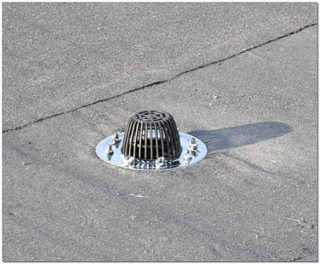
On such roofs, people regularly climb to carry out certain activities. For example, observation decks are arranged on the surface of multi-storey buildings, which require a special coating material, but also the installation of low walls, parapets and railings. A drainage system is added to the structure to reduce the effect of moisture on a loaded roof.
An exploited straight roof is:
- inversion;
- ventilated.
The thermal insulation layer is made with extruded polystyrene foam or plate insulation. The surface is covered with paving slabs or ceramic material. For the operated structure, reinforced floor slabs are installed.
Ventilated ceiling means the organization between the insulation and the moisture-proof membrane of the minimum empty space for the circulation of air flows. So the thermal protective material is protected from excess moisture.
Unexploited
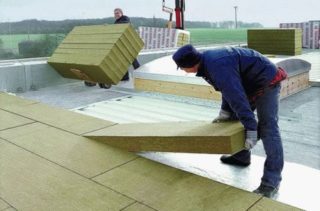
This type cannot be constantly operated, at the same time a large number of people and equipment can be on it. It can be climbed, it will not harm the upper deck. On unexploited types, antennas, security cameras, meteorological instruments are placed.
Such overlaps are used for the work of repairmen, installation of transfer station modules. For regular operational and technical maintenance, reading the readings of video cameras and sensors, special ramps are erected for people to pass, to place tools and materials.
It is not necessary to use rigid insulation in the form of slabs; you can install soft insulation from the cold. The wear resistance of an unexploited coating is much lower than that of a regularly used one, therefore, reconstruction is needed before the construction of a resting place there. The flooring surface without people is cheaper, but has a shorter service life.
Traditional
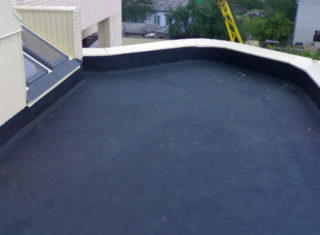
In this type of roof, the insulation is placed under a layer of insulation from moisture in order to protect it from absorbing liquid. In this design, the waterproofing film is considered a weak point.
The membrane is affected by:
- aggressive atmospheric factors;
- solar radiation;
- drops of heat and cold;
- mechanical forces (in the case of an exploited version).
Leaks in traditional coatings are difficult to detect, and repairs are time consuming and laborious. Install aerators (one per 50 m²) so that water does not penetrate the thermal protection layer.Moisture enters in the form of condensation drops, accumulates in the cement screed, remains in the layers of the old structure.
In roofs with a traditional coating, roofing material is used on bitumen, which is laid in 3 layers or more, depending on the degree of inclination of the surface. To increase the strength on the area of roofing material, sand spreading is made, which is fused at the factory.
Inversion
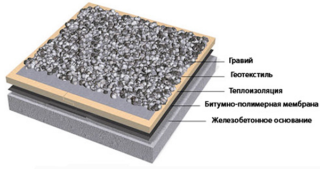
In the roofing cake, the waterproofing membrane quickly wore out. Previously, such protection was organized in layers of roofing tar, which was a medium-thickness cardboard impregnated with liquid compositions based on bitumen. Its location in the upper part of the roofing scheme led to the fact that it collapses faster than other materials, because its strength is low.
The way out was the discovery of a new type of laying of materials, which received the name inversion roof. This type means an overlap, the scheme of which is inverted in comparison with the traditional view - the waterproofing is placed under a thermal insulation layer. In such roofing structures, moisture insulation is not destroyed by impacts, frost and rays.
It is customary to replace the roofing layer with technological materials, for example, membranes of the TechnoNIKOL brand are used. The roll layer is used to waterproof the roof. It is produced from rotting components, which are organically combined in the base of a thick film.
Subtleties of waterproofing
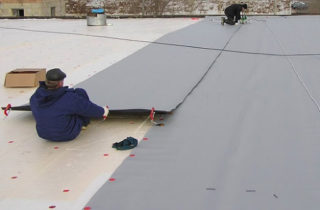
Polymeric membranes have been used for a long time to talk about their positive qualities. The film serves for a long time, belongs to environmentally friendly materials, does not burn. Of the three layers, two outer ones are made of polyvinyl chloride, and the middle one is made of polyester with fiber reinforcement.
The following types of PVC films are produced to make a flat roof device:
- The anti-condensation type is produced on a non-woven base, which absorbs moisture and does not contribute to condensation. Such protection is used in flat, unexploited roofs covered with corrugated sheet.
- Perforated films with microscopic holes are placed under various roofing materials, but ventilation gaps must be arranged between them and the insulation.
- EPDM films are made from rubber that has been plastic-compressed at high temperatures. Hydroizol serves for a long time without loss of quality, and is not afraid of the sun. The composition of the roof is laid on acrylic glue.
The coating insulation from moisture is performed with bituminous mastics, which differ in properties. The material serves for 20 years, adheres to different surfaces, but by the end of operation it loses its plasticity and ability to resist impacts.
Ventilation features
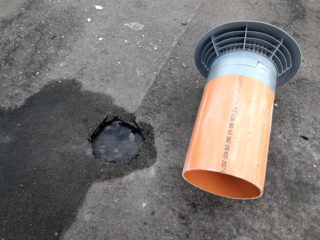
An unventilated roof accumulates condensation, which, under its own weight, flows down onto the floor slabs, manifests itself inside the room as drips on the ceiling and walls. Constant humidification renders buildings and roof structures unusable.
Aerators are represented in the roof by a system of steel or plastic pipes. The devices are placed in high areas of the surface and protected from contamination with special caps. They work on the principle of moving air flows under the influence of different pressures from under the ventilation space under the roof. Ascending jets carry moisture particles and remove it from the structure of the roofing cake.
Difficulties arise when installing aerators in an exploited roof, because the material of the topcoat does not always allow this to be done. The tube penetrates all layers and reaches the vapor barrier. The hole from which the branch pipe protrudes is carefully sealed with rubber.
Flat roof drainage device
A small part of the water from precipitation falls from the roof under the influence of gravity. the roof has a slight slope.The bulk of the water is directed to the internal organized funnels. Such openings are designed together with the roof and calculated before building the building. The calculation determines the correct diameter of the drainage channel. The intensity of precipitation in the region is taken into account so that the pipe can divert the flow without delay in heavy rainfall.
Several such funnels are placed depending on the area of the roof. The slope of the roof is made towards them to help water get into the gutters. Some internal drainage systems are equipped with artificial heating so that icing does not occur at negative temperatures.








